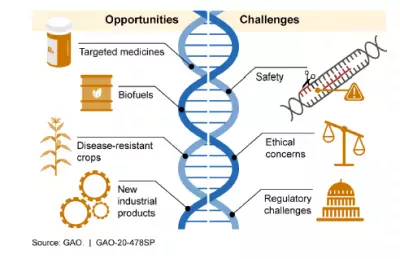CRISPR: A Technology That Could Help In the Fight Against COVID-19
As work continues around the globe to diagnose and treat patients with COVID-19 (coronavirus), today’s WatchBlog looks at a technology that may help scientists develop new diagnostic tests for rapidly identifying the virus—a critical component in the fight against the disease.
CRISPR (Clustered Regularly Interspaced Palindromic Repeats) is a gene-editing technology that allows scientists to make specific, targeted changes to DNA. Its development began when scientists noticed that bacteria use a repeating DNA sequence to “remember” an attacking virus. This allows the bacteria to defend itself from subsequent viral attacks.
Scientists started to use these same repeating DNA sequences to “remember” a specific DNA sequence. Then, they use a protein called CAS9 to cut out that DNA so that they can add, delete, or modify it.
Scientists can make targeted changes to an organism’s DNA using CRISPR gene editing.
The below figure shows how CRISPR/CAS9 gene editing systems allow scientists to make targeted changes to an organism’s DNA.
Because it is faster, cheaper, more accurate, and more efficient than prior methods, CRISPR is used extensively worldwide to research the development of new medical treatments, including treatments for sickle cell anemia and some types of cancer.
To develop a diagnostic test for COVID-19, scientists use the same repeating sequences to “remember” the RNA of the virus that causes COVID-19 (SARS-COV-2). Then, they use a different type of CAS protein and “reporter molecules” that produce a visual cue. For example, these molecules may change color when the viral RNA is present. Scientists know the viral RNA is present when they see the color change.
Want to know more? Check out our Science & Tech Spotlight on CRISPR. GAO also has a broad portfolio of work on the federal government’s response to and preparedness for infectious diseases, viruses, and biological threats—including Zika, Ebola, Avian Influenza, and H1N1. April 25—known as National DNA Day—is a great time to learn more about how far scientists and researchers have come in understanding DNA.
Comments on GAO’s WatchBlog? Contact blog@gao.gov.
GAO Contacts
Related Products

GAO's mission is to provide Congress with fact-based, nonpartisan information that can help improve federal government performance and ensure accountability for the benefit of the American people. GAO launched its WatchBlog in January, 2014, as part of its continuing effort to reach its audiences—Congress and the American people—where they are currently looking for information.
The blog format allows GAO to provide a little more context about its work than it can offer on its other social media platforms. Posts will tie GAO work to current events and the news; show how GAO’s work is affecting agencies or legislation; highlight reports, testimonies, and issue areas where GAO does work; and provide information about GAO itself, among other things.
Please send any feedback on GAO's WatchBlog to blog@gao.gov.





